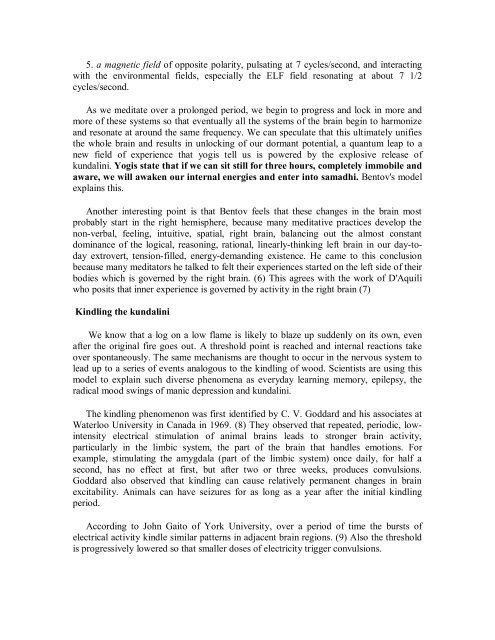Kundalini.Tantra.by.Satyananda.Saraswati
You also want an ePaper? Increase the reach of your titles
YUMPU automatically turns print PDFs into web optimized ePapers that Google loves.
5. a magnetic field of opposite polarity, pulsating at 7 cycles/second, and interacting<br />
with the environmental fields, especially the ELF field resonating at about 7 1/2<br />
cycles/second.<br />
As we meditate over a prolonged period, we begin to progress and lock in more and<br />
more of these systems so that eventually all the systems of the brain begin to harmonize<br />
and resonate at around the same frequency. We can speculate that this ultimately unifies<br />
the whole brain and results in unlocking of our dormant potential, a quantum leap to a<br />
new field of experience that yogis tell us is powered <strong>by</strong> the explosive release of<br />
kundalini. Yogis state that if we can sit still for three hours, completely immobile and<br />
aware, we will awaken our internal energies and enter into samadhi. Bentov's model<br />
explains this.<br />
Another interesting point is that Bentov feels that these changes in the brain most<br />
probably start in the right hemisphere, because many meditative practices develop the<br />
non-verbal, feeling, intuitive, spatial, right brain, balancing out the almost constant<br />
dominance of the logical, reasoning, rational, linearly-thinking left brain in our day-today<br />
extrovert, tension-filled, energy-demanding existence. He came to this conclusion<br />
because many meditators he talked to felt their experiences started on the left side of their<br />
bodies which is governed <strong>by</strong> the right brain. (6) This agrees with the work of D'Aquili<br />
who posits that inner experience is governed <strong>by</strong> activity in the right brain (7)<br />
Kindling the kundalini<br />
We know that a log on a low flame is likely to blaze up suddenly on its own, even<br />
after the original fire goes out. A threshold point is reached and internal reactions take<br />
over spontaneously. The same mechanisms are thought to occur in the nervous system to<br />
lead up to a series of events analogous to the kindling of wood. Scientists are using this<br />
model to explain such diverse phenomena as everyday learning memory, epilepsy, the<br />
radical mood swings of manic depression and kundalini.<br />
The kindling phenomenon was first identified <strong>by</strong> C. V. Goddard and his associates at<br />
Waterloo University in Canada in 1969. (8) They observed that repeated, periodic, lowintensity<br />
electrical stimulation of animal brains leads to stronger brain activity,<br />
particularly in the limbic system, the part of the brain that handles emotions. For<br />
example, stimulating the amygdala (part of the limbic system) once daily, for half a<br />
second, has no effect at first, but after two or three weeks, produces convulsions.<br />
Goddard also observed that kindling can cause relatively permanent changes in brain<br />
excitability. Animals can have seizures for as long as a year after the initial kindling<br />
period.<br />
According to John Gaito of York University, over a period of time the bursts of<br />
electrical activity kindle similar patterns in adjacent brain regions. (9) Also the threshold<br />
is progressively lowered so that smaller doses of electricity trigger convulsions.














![[Lonely Planet] Sri Lanka](https://img.yumpu.com/59845622/1/169x260/lonely-planet-sri-lanka.jpg?quality=85)


